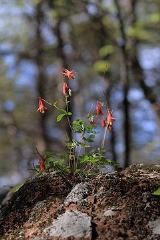
Wild Columbine
Encyclopedia
Aquilegia canadensis is a herbaceous
perennial
native to woodland
and rocky slopes in eastern North America
, prized for its red and yellow flowers. It readily hybridizes with other species in the genus.
Flowers are 1-2 inches long and have yellow petal
s with a red spur and red sepal
s. They appear in late spring, nodding on stems above the leaves. The round end of the spur contains nectar, which is sought by butterflies and hummingbirds.
The caterpillars of Columbine Duskywing
(Erynnis lucilius) feed on the leaves.
The cultivar 'Little Lanterns' is half the height of the species.
Herbaceous plant
A herbaceous plant is a plant that has leaves and stems that die down at the end of the growing season to the soil level. They have no persistent woody stem above ground...
perennial
Perennial plant
A perennial plant or simply perennial is a plant that lives for more than two years. The term is often used to differentiate a plant from shorter lived annuals and biennials. The term is sometimes misused by commercial gardeners or horticulturalists to describe only herbaceous perennials...
native to woodland
Woodland
Ecologically, a woodland is a low-density forest forming open habitats with plenty of sunlight and limited shade. Woodlands may support an understory of shrubs and herbaceous plants including grasses. Woodland may form a transition to shrubland under drier conditions or during early stages of...
and rocky slopes in eastern North America
North America
North America is a continent wholly within the Northern Hemisphere and almost wholly within the Western Hemisphere. It is also considered a northern subcontinent of the Americas...
, prized for its red and yellow flowers. It readily hybridizes with other species in the genus.
Description
Height is 15–90 cm (5.9–35.4 in). Leaves are lobed and grouped in 3s, growing from the base and off the flowering stems.Flowers are 1-2 inches long and have yellow petal
Petal
Petals are modified leaves that surround the reproductive parts of flowers. They often are brightly colored or unusually shaped to attract pollinators. Together, all of the petals of a flower are called a corolla. Petals are usually accompanied by another set of special leaves called sepals lying...
s with a red spur and red sepal
Sepal
A sepal is a part of the flower of angiosperms . Collectively the sepals form the calyx, which is the outermost whorl of parts that form a flower. Usually green, sepals have the typical function of protecting the petals when the flower is in bud...
s. They appear in late spring, nodding on stems above the leaves. The round end of the spur contains nectar, which is sought by butterflies and hummingbirds.
The caterpillars of Columbine Duskywing
Duskywing
Erynnis is a genus in the Skippers butterfly family, Hesperiidae, known as the Duskywings.-Species and notable subspecies:Listed alphabetically.*Erynnis afranius – Afranius Duskywing...
(Erynnis lucilius) feed on the leaves.
Cultivation
The plant is easily propagated from seed and blooms the second year. It is relatively long lived in the garden. It grows well in shade, and in sun with proper moisture.The cultivar 'Little Lanterns' is half the height of the species.
Toxicity
Canada columbine contains a cyanogenic glycoside, which releases poisonous hydrogen cyanide when the plant is damaged.Distribution
USA (AL, AR, CT, DC, DE, FL, GA, IA, IL, IN, KS, KY, MA, MD, ME, MI, MN, MO, MS, NC, ND, NE, NH, NJ, NY, OH, OK, PA, RI, SC, SD, TN, TX, VA, VT, WI, WV), CANADA (MB, NB, ON, QC, SK)Wetland Indicator Status
Regions 1-5: Facultative Equally (FAC) likely to occur in wetlands or non-wetlands (estimated probability 34%-66%).- Region 6: Facultative Wetland (FACW) Usually occurs in wetlands (estimated probability 67%-99%), but occasionally found in non-wetlands.
External links
- Flora of North America — map
- Native Plant Identification Network
- Germplasm Resources Information Network
- US Forest Service — Celebrating Wildflowers
- PlantFiles
- Connecticut Botanical Society
- Missouri Plants
- Illinois Wildflowers
- Michigan Department of Natural Resources
- Minnesota Wildflowers
- Floridata
- 'Little Lanterns' — Paghat's Garden
- CalPhotos

